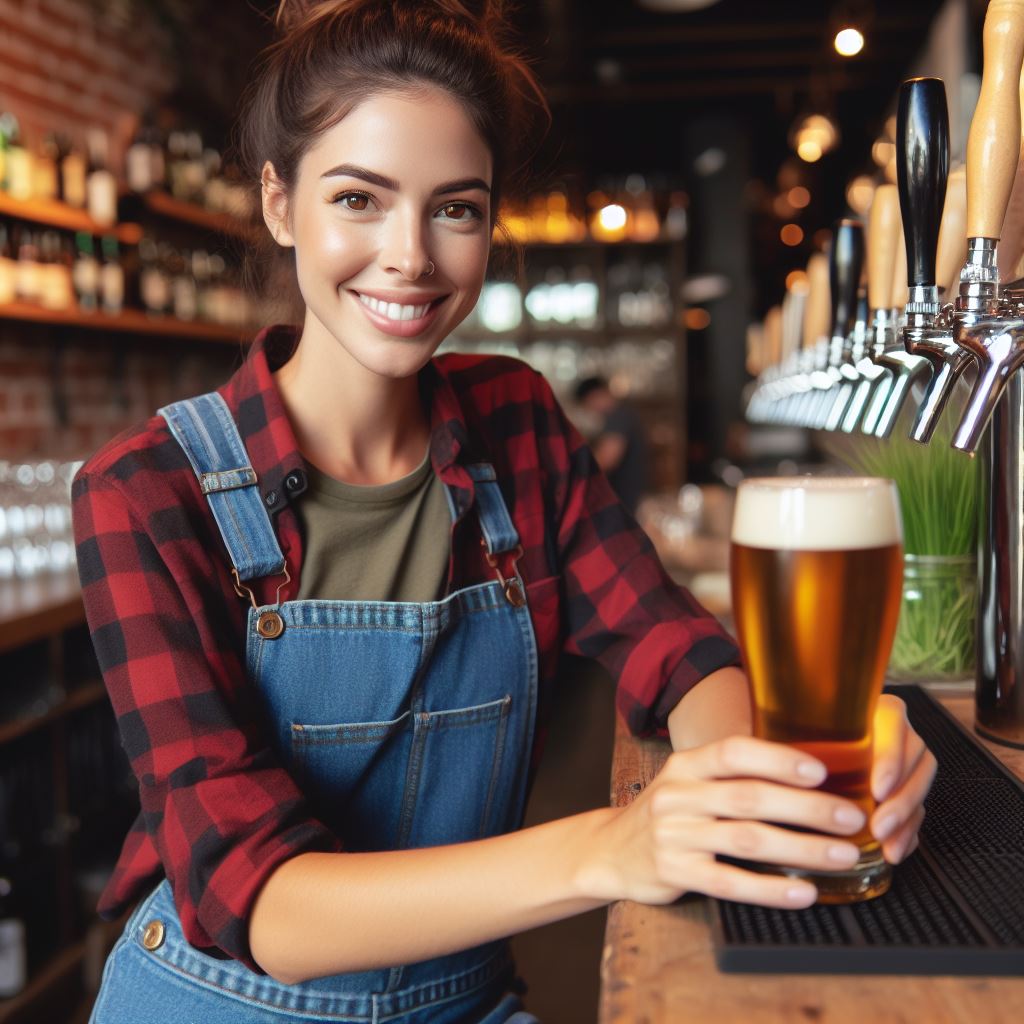Introduction
In the dynamic realm of bartending, prioritizing health and safety is paramount for a thriving and secure work environment.
Acknowledging the pivotal role these aspects play ensures the well-being of bartenders and patrons alike.
Understanding the potential risks and hazards inherent in bartending jobs is crucial.
From handling glassware and dealing with various ingredients to managing crowds and maintaining a fast-paced workflow, bartenders encounter diverse challenges daily.
Glass breakages, exposure to hazardous substances, and slip-and-fall incidents pose immediate threats.
Addressing these concerns head-on through effective health and safety measures is indispensable.
Bartenders must be equipped with the knowledge and skills necessary to navigate these occupational hazards.
Proper training on safe handling practices, emergency procedures, and sanitation protocols empowers them to proactively mitigate risks.
This introduction sets the stage for a comprehensive exploration of health and safety in bartending, emphasizing its significance in fostering a secure and flourishing environment for both professionals and patrons.
Understanding Bartending Hazards
In any bartending job, it is crucial to be aware of potential hazards to ensure health and safety for both employees and customers.
Here are some common hazards to keep in mind:
Identifying Common Hazards
- Slips, trips, and falls: Due to spilled drinks, wet floors, or cluttered areas, bartenders can easily slip or trip.
- Handling and storing alcoholic beverages: Alcohol is flammable and should be handled carefully to avoid accidents.
- Working with sharp tools: Bartenders often use knives and glassware, which can pose a risk if not handled properly.
Risks Associated with Handling and Storing Alcoholic Beverages
When it comes to handling and storing alcoholic beverages, there are several risks to consider:
- Flammability: Alcohol is highly flammable, and improper storage or handling can lead to severe accidents.
- Chemical exposure: Some cleaning agents used in bars can react with alcoholic beverages, causing harmful fumes or chemical reactions.
- Proper lifting techniques: Moving heavy kegs or cases of alcohol incorrectly can result in back strains or other injuries.
Potential Dangers of Working with Sharp Tools
Working with sharp tools, such as knives and glassware, requires caution to prevent injuries:
- Knife handling: Bartenders should always use sharp knives with care, ensuring proper cutting techniques and keeping blades away from others.
- Broken glassware: Accidental breakage can occur, resulting in cuts or puncture wounds. Proper disposal and handling techniques are essential.
- Safe glassware storage: Glassware should be organized and stored securely to avoid breakage that could cause harm to bartenders or customers.
Overall, bartending jobs come with potential hazards that should not be overlooked.
By understanding and addressing these risks, bartenders can create a safer working environment for themselves and provide a better experience for their customers.
Ergonomics: Promoting a Healthy Work Environment
In the fast-paced world of bartending, it’s easy to overlook the importance of proper ergonomics.
However, practicing good ergonomic habits is crucial for maintaining a healthy work environment and preventing potential injuries.
Here are some key points to consider:
The Significance of Proper Ergonomic Practices
- Reduced risk of musculoskeletal disorders and repetitive strain injuries (RSIs).
- Improved productivity and efficiency by minimizing physical strain.
- Enhanced overall well-being and job satisfaction for bartenders.
Importance of Using Comfortable and Supportive Footwear
- Investing in high-quality shoes offers better support for your feet and prevents discomfort.
- Reduced risk of foot problems such as plantar fasciitis, blisters, and calluses.
- Proper footwear also aids in preventing slips, trips, and falls behind the bar.
Maintaining Good Posture and Techniques for Safe Lifting and Carrying
- Practice maintaining an upright posture to minimize strain on your back and neck.
- Keep your core engaged while lifting heavy items, using your legs instead of your back.
- Use proper techniques like keeping the load close to your body and bending your knees.
- Take frequent breaks and avoid overexertion to prevent fatigue and injury.
By implementing these ergonomic practices, bartenders can ensure their health and safety while on the job.
Personal Protective Equipment (PPE)
The use of PPE to prevent injuries and illnesses
- Always prioritize your safety by wearing the appropriate personal protective equipment (PPE).
- Protective equipment such as gloves, goggles, and aprons should be worn at all times.
- Using PPE reduces the risk of accidents and minimizes the chances of acquiring work-related illnesses.
- PPE plays a vital role in safeguarding your health and well-being in the bartending industry.
- Be diligent in learning about the specific PPE requirements in your workplace.
- Wearing PPE is not just a suggestion, but a crucial requirement to maintain a safe working environment.
- Failure to use the appropriate PPE can result in serious injuries or long-term health issues.
- Adhere to the PPE guidelines set by your employer to ensure a hazard-free workplace.
- When using chemicals, always wear gloves and other protective gear to prevent chemical exposure.
- PPE acts as a barrier between you and potential hazards, protecting your body from harm.
Importance of wearing non-slip shoes to prevent falls
- Invest in high-quality non-slip shoes to reduce the risk of slips and falls in the bartending industry.
- Slippery surfaces are common in bars, and wearing appropriate footwear is crucial for stability.
- Non-slip shoes provide better traction on wet floors, preventing accidents in fast-paced environments.
- Choose shoes with slip-resistant soles and proper arch support to increase stability.
- Wearing non-slip shoes not only protects you but also enhances your performance behind the bar.
- Walking on slippery surfaces with regular shoes can lead to severe injuries.
- Non-slip shoes are an essential investment for bartenders, mitigating the risk of workplace accidents.
- Never compromise on the quality of your footwear, as it can significantly impact your safety.
- Pay attention to the condition of your shoes and replace them when the soles wear out.
- Ensure that your shoes fit properly to avoid discomfort and potential accidents.
The need for gloves to protect against cuts, burns, and chemical exposure
- Bartenders require essential personal protective equipment, with gloves being indispensable for various tasks.
- Use cut-resistant gloves when handling sharp tools and knives to prevent accidental cuts.
- Thermal-resistant gloves are crucial for protection against burns from hot glassware or liquids.
- Wearing appropriate gloves minimizes the risk of chemical exposure, a common hazard in bartending.
- Vinyl, latex, or nitrile gloves act as barriers against harmful chemicals, preventing skin irritation.
- Wear gloves during cleaning tasks involving chemicals and disinfectants to ensure safety.
- Change gloves frequently to avoid cross-contamination and maintain hygiene standards.
- Consistent glove usage when handling hazardous substances prevents accidental ingestion or absorption.
- Proper glove selection and usage are vital for self-protection and maintaining a safe work environment.
- In the bartending industry, personal protective equipment, including gloves, is a requirement for a safe workplace.
- Prioritize safety by adhering to PPE guidelines, reducing the risk of accidents and work-related illnesses.
- Non-slip shoes are essential for stability, preventing slips and falls on slippery bar surfaces.
- Invest in high-quality non-slip shoes with slip-resistant soles and proper arch support for added safety.
- Ensure consistent use of PPE to minimize the risk of serious injuries or long-term health issues.
- Embrace PPE in your bartending job for proactive self-protection and maintaining a hazard-free workplace.
Read: Hotel Management: Degrees & Certifications in Canada
Handling and Storing Alcoholic Beverages Safely
Handling and storing alcoholic beverages safely is crucial for the health and safety of bartenders and customers in a bar environment.
This section will provide guidelines for safe handling and storage of alcohol, discuss the importance of proper lifting techniques when moving heavy kegs or cases of alcohol, and highlight the significance of monitoring and controlling noise levels.
Guidelines for Safe Handling and Storage of Alcohol
- Always wear appropriate personal protective equipment, such as gloves and safety glasses, when handling alcohol.
- Store alcohol in a cool, dry place away from direct sunlight and sources of heat.
- Ensure that alcohol containers are tightly sealed to prevent leaks or spills.
- Separate flammable and combustible liquids from alcohol to minimize fire hazards.
- Keep alcohol containers away from chemicals or cleaning agents to avoid contamination.
- Follow proper labeling and identification procedures to distinguish different types of alcohol.
Importance of Proper Lifting Techniques
- When moving heavy kegs or cases of alcohol, use proper lifting techniques to prevent injuries.
- Bend your knees and keep your back straight while lifting to reduce strain on your back.
- Use mechanical aids, such as dollies or forklifts, to assist with lifting heavy loads.
- Avoid twisting your body while lifting, as it can strain your muscles and cause back injuries.
- If a load is too heavy to lift alone, seek assistance from a coworker to ensure safe handling.
Significance of Monitoring and Controlling Noise Levels
- Excessive noise levels in a bar environment can have detrimental effects on bartender’s health and customer experience.
- Regularly monitor noise levels using sound monitoring devices to identify potential noise hazards.
- Implement noise control measures, such as installing soundproofing materials or adjusting speaker volume.
- Educate bartenders and staff about the importance of controlling noise levels and maintaining a comfortable atmosphere.
- Encourage customers to respect the noise regulations and remind them to keep their voices at a reasonable level.
By following the guidelines for safe handling and storage of alcohol, bartenders can minimize the risk of accidents or incidents related to alcohol.
Proper lifting techniques not only protect bartenders from injuries but also ensure the integrity of the alcohol containers.
Monitoring and controlling noise levels in a bar environment contribute to a safe and comfortable atmosphere for both bartenders and customers.
Overall, health and safety in bartending jobs should be a top priority.
It is essential to provide bartenders with proper training on safe handling and storage of alcohol, including guidelines for lifting heavy loads.
Additionally, maintaining a controlled noise level in the bar environment can contribute to the well-being and satisfaction of both bartenders and customers.
By implementing these measures, bartenders can create a safe and enjoyable experience for everyone involved.
Read: Emerging Trends in Canadian Hotel Management

Preventing Cross-Contamination and Foodborne Illnesses
Importance of maintaining hygiene and cleanliness behind the bar
Maintaining hygiene and cleanliness behind the bar is crucial for preventing cross-contamination and foodborne illnesses.
Tips for proper cleaning and sanitization of utensils, glassware, and bar surfaces
To ensure proper cleaning and sanitization of utensils, glassware, and bar surfaces:
- Wash utensils, glassware, and bar surfaces with hot, soapy water after each use.
- Rinse them thoroughly to remove any remaining soap.
- Sanitize them using an approved sanitizer, following the manufacturer’s instructions.
- Allow utensils, glassware, and bar surfaces to air dry.
The need for bartenders to follow food safety protocols when handling garnishes or preparing drinks that include food items
Bartenders must also follow food safety protocols when handling garnishes or preparing drinks with food items.
- Wash hands thoroughly with soap and warm water before handling any food or garnishes.
- Wash and sanitize all cutting boards, knives, and other tools before and after use.
- Use separate cutting boards and utensils for raw and ready-to-eat foods to avoid cross-contamination.
- Store garnishes properly, refrigerating them at the appropriate temperature.
- Discard any garnishes that have come into contact with unclean surfaces or hands.
- When preparing drinks with food items, ensure that they are fresh and stored properly.
- Avoid bare-hand contact with ready-to-eat foods; use utensils or gloves instead.
– Regularly clean and sanitize the bar area to prevent the buildup of bacteria and other contaminants.
- Wipe down bar surfaces with a sanitizer solution at regular intervals.
- Clean spillage immediately to prevent slips and falls.
- Regularly clean and sanitize ice bins, ice scoops, and other equipment used for serving drinks.
- Empty, clean, and sanitize sinks and drainboards regularly.
- Ensure proper disposal of waste and regularly clean trash bins.
Monitor and maintain the cleanliness of refrigerator units for safe food storage.
- Regularly clean and sanitize the refrigerator interior.
- Check food items for expiration dates and remove any expired or spoiled items.
- Organize food items properly to avoid cross-contamination.
- Monitor refrigerator temperatures to ensure they are within the safe range.
By following these hygiene and cleanliness practices, bartenders can prevent cross-contamination and foodborne illnesses, ensuring the health and safety of their customers.
Read: Salary Guide: Hotel Managers in Canada 2024
Dealing with Intoxicated Customers and Conflict Resolution
Potential Risks with Dealing with Intoxicated Customers
- Physical aggression and violence may arise from intoxicated customers.
- Incoherent speech and impaired judgment may lead to misunderstandings and conflicts.
- Intoxicated customers can become a liability for bartending establishments if accidents occur.
- The presence of intoxicated customers can negatively impact the overall atmosphere and experience for other customers.
- Intoxication can impair a customer’s ability to understand and follow safety protocols, putting themselves and others at risk.
Strategies for Diffusing Tense Situations and Ensuring Safety
- Stay calm and composed when dealing with an intoxicated customer to avoid escalating the situation.
- Communicate clearly and actively listen to the customer’s concerns, showing empathy and understanding.
- Use de-escalation techniques such as offering options or suggesting alternative drinks with lower alcohol content.
- Respond promptly to any signs of aggression or harassment, ensuring the safety of both staff and customers.
- Encourage non-confrontational methods of conflict resolution, such as seeking a compromise or involving a manager if necessary.
Guidance on Identifying Signs of Intoxication and Refusing Service
- Observe for slurred speech, unsteady balance, and bloodshot eyes as potential signs of intoxication.
- Note excessive consumption of alcohol within a short period, indicating a higher likelihood of intoxication.
- Watch for changes in behavior, such as increased aggression or overly loud and disruptive behavior.
- Train bartending staff to recognize signs of intoxication and provide clear guidelines on when to refuse service.
- Ensure bartenders use discretion and judgment when making decisions about refusing service, always prioritizing safety.
Safeguarding the Well-being of Staff and Customers
- Implement a well-defined policy on dealing with intoxicated customers, including procedures for intervention and refusal of service.
- Educate bartending staff on responsible alcohol service and strategies for preventing conflicts with intoxicated customers.
- Provide training on self-defense techniques and conflict resolution skills to staff, empowering them to handle difficult situations.
- Foster a supportive work environment where staff can report any concerns or incidents involving intoxicated customers without fear of retribution.
- Regularly assess the effectiveness of safety protocols and update them as needed to adapt to changing circumstances.
Dealing with intoxicated customers is an inevitable challenge in bartending jobs.
By recognizing the potential risks and implementing effective strategies for conflict resolution, bartenders can ensure the safety and well-being of both staff and customers.
Identifying signs of intoxication and knowing when to refuse service are crucial in maintaining a responsible and secure environment.
By prioritizing safety and providing training and support, bartending establishments can create a more enjoyable and secure experience for everyone involved.
Read: Interviewing a Hotel Manager: Insider’s View
Unlock Your Career Potential
Visualize a clear path to success with our tailored Career Consulting service. Personalized insights in just 1-3 days.
Get StartedExplore Further: Top Trends in Canadian Culinary Arts
Delve into the Subject: Famous Canadian Chefs and Their Signature Dishes
Mental Health and Well-being in Bartending
The Importance of Acknowledging and Addressing Mental Health Concerns in the Bartending Industry
1. Recognizing the Mental Health Challenges in Bartending
Working in the bartending industry can be mentally demanding, as it often involves long hours, high-pressure environments, and dealing with difficult or intoxicated customers.
These challenges can have a significant impact on a bartender’s mental health and well-being.
2. The Stigma Surrounding Mental Health
Due to the nature of the job, there is a stigma surrounding mental health in the bartending industry.
Bartenders may feel reluctant to seek help or talk openly about their mental health struggles due to the fear of being judged or seen as weak.
3. Breaking the Stigma
It is crucial for both bartenders and employers to break the stigma surrounding mental health in the industry.
By creating an open and supportive work environment, bartenders will feel more comfortable seeking help when needed.
4. Tips for Managing Stress
Stress is a common issue in the bartending industry, but there are ways to manage it effectively:
- Practice relaxation techniques, such as deep breathing or meditation, during breaks.
- Engage in regular exercise to reduce stress and improve overall well-being.
- Establish a regular sleep routine to ensure proper rest and recovery.
5. Promoting a Healthy Work-Life Balance
Maintaining a healthy work-life balance is essential for bartenders to avoid burnout and protect their mental health:
- Set boundaries and be assertive about your availability outside work hours.
- Prioritize self-care activities, such as spending time with loved ones or pursuing hobbies.
- Take regular breaks and plan vacations to recharge and rejuvenate.
6. Seeking Support and Resources
Bartenders should not hesitate to seek support and utilize available resources for coping with the demands of their job:
- Reach out to friends, family, or colleagues for emotional support.
- Consider joining support groups or online communities specific to the bartending industry.
- Explore counseling or therapy options to address underlying mental health concerns.
- Look for employee assistance programs that may offer confidential counseling services.
7. The Role of Employers
Employers in the bartending industry should prioritize the mental health and well-being of their staff:
- Provide mental health education and training to all employees.
- Implement policies that encourage a healthy work environment and work-life balance.
- Offer regular breaks, time off, and flexible schedules to support employee well-being.
- Develop a support system within the workplace, such as Employee Assistance Programs (EAPs) or confidential helplines.
8. The Benefits of Addressing Mental Health Concerns
By acknowledging and addressing mental health concerns in the bartending industry, both bartenders and employers can benefit:
- Bartenders will experience improved mental well-being and decreased risk of burnout.
- Employers will have a more motivated and productive workforce, leading to increased customer satisfaction.
- The industry as a whole will have a positive reputation, attracting more skilled individuals to bartending careers.
In review, mental health and well-being play a crucial role in the bartending industry.
It is essential to acknowledge and address mental health concerns, break the stigma surrounding mental health, and provide support and resources to bartenders.
By managing stress, promoting work-life balance, and seeking support when needed, bartenders can maintain their mental well-being and thrive in their careers.
Conclusion
To recap, this blog section has highlighted the importance of prioritizing health and safety in bartending jobs.
The nature of the work puts bartenders at risk, but with the implementation of proper guidelines and tips, a safer work environment can be achieved.
It is crucial for bartenders to understand the potential hazards and take appropriate measures to mitigate them.
By practicing good hygiene, regularly cleaning and sanitizing workstations, and using protective equipment, bartenders can protect themselves and their customers.
Additionally, recognizing the signs of alcohol intoxication and knowing how to handle difficult situations professionally is essential for maintaining a safe environment in bars and clubs.
Implementing responsible alcohol service practices, such as checking IDs and monitoring alcohol consumption, is vital.
By implementing the tips and guidelines provided in this blog section, bartenders can greatly reduce the risks associated with their job.
Prioritizing health and safety not only ensures the well-being of both the bartender and customers but also builds trust and credibility in the industry.
It is our hope that this blog section has provided valuable information and insights to bartenders.
We encourage you to take the necessary steps to create a safe work environment and implement these guidelines in your bartending career.
By doing so, you not only protect yourself but also contribute to a vibrant and responsible industry.
Stay safe!




